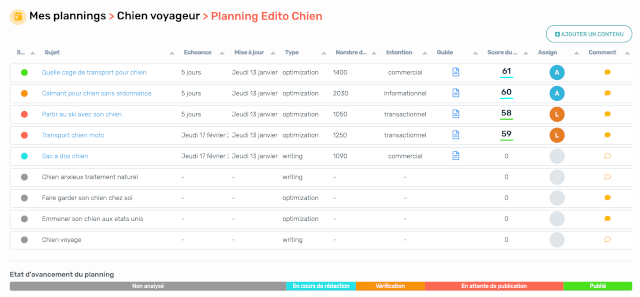Do you know the principle and need for implementing a content strategy? But the elements that make up an editorial strategy seem unclear to you? I propose to try to solve this problem! By comparing each of these concepts, you will soon know how to take action. Line, charter, planning, discover without further delay everything you need to know to optimize your business communication and effectively promote your brand.
🚀 Quick read: 2 minutes to know all the elements of an editorial strategy
Do you have only a few minutes to get a general overview of the different elements that make up an editorial strategy? Here are the key points you absolutely need to know!
The 3 key elements of an editorial strategy
- Editorial line: how to create content for your website and social media?
- Editorial charter: why create content to promote and differentiate your business while reaching your target audience?
- Content calendar: when to publish your content, how to ensure its optimization, and maintain an overview?
The difference between an editorial strategy and an editorial line
The editorial line is part of your content marketing. While an editorial strategy is the guiding element of your content creation, the editorial line is the thread that ensures the consistency of your communication and the relevance of your brand.
The difference between an editorial line and an editorial charter
The editorial charter specifies the reason for creating content in the way you have decided, while the editorial line explains how to write to achieve the goals you have set.
The importance of a content calendar
There are at least 7 good reasons to set up a publication schedule!
- Maintain an overview of your editorial team's work.
- Know the progress of your various projects.
- Organize content creation effectively.
- Plan your budget.
- Don't miss an important date.
- Achieve your business goals.
- Improve your organic search ranking.
📈 What is the main goal of an editorial strategy?

First of all, it seems important to remind you why it is so important to take the time to set up an editorial strategy for your business communication.
Its primary goal is to promote your brand on the Internet to increase your revenue in the long term. To achieve this goal, you must organize all the elements of a high-performance and sustainable editorial strategy. This will allow you to:
- Organize your content marketing: all the players in your editorial strategy have the same guideline.
- Speak with a single voice: the creation of your content is consistent and harmonious across all your communication channels.
- Strengthen your brand image: your digital communication is coherent and allows the reader to easily identify you.
- Produce quality content: the editorial guide ensures the relevance and value of your content.
- Assert your area of expertise: by addressing your topics comprehensively, you demonstrate your broad level of competence.
- Optimize your organic search ranking: with the help of keyword clustering and a precise writing guide, you boost your SEO.
- Meet the needs of your customers and prospects: after identifying the expectations of your audience, you offer them personalized content.
- Support your buyers in the sales process: the buying journey is analyzed and optimized to increase your conversion rate.
- Improve your sales results: the links created with your prospects and customers improve your sales in the short and long term.
🌱 How to implement the different elements of a content strategy?

When you want to create an effective content strategy, you must follow a precise methodology. To do this, I suggest you not to neglect any of the 6 steps proposed below. Only by respecting this procedure will you be able to achieve your goals.
- Analyze the data: define your buyer persona, determine the culture of your company, analyze your competition, and check the existing content.
- Build an editorial team: carefully choose the different content marketing professions you need to achieve your goal.
- Establish an editorial line: the editorial line is the guiding thread that harmonizes the creation of your content on your website and social networks.
- Define an editorial charter: this document serves to guarantee the quality and relevance of all your content across all communication channels.
- Create a content calendar: in the content calendar, you plan and harmonize your upcoming publications on the Web.
- Monitor the editorial strategy: regularly check the effectiveness of your content strategy and adapt it according to the results obtained.
👨🏫 What is the difference between editorial strategy and editorial line?

To properly understand the difference between an editorial strategy and an editorial line, you must fully understand the meaning of these two concepts.
- Definition of an editorial strategy: it is the fundamental pillar of the entirety of your content marketing. It serves to specify each of your actions in the short, medium, and long term. Therefore, the editorial strategy directs your business communication on the Web and the work of all your collaborators. It harmonizes your content, makes it more relevant, and ensures its quality. This document also allows you to answer the fundamental questions of your content creation:
- Why write?
- To whom address?
- When to publish?
- Where to promote?
- What to talk about?
- Definition of an editorial line: it is the guiding thread of your content creation. It allows you to represent the identity of your brand and ensures its credibility with your audience. The editorial line is therefore essential for conveying a consistent message in each of your publications. In this writing guide, you add all the elements that serve to represent the values of your company and effectively reach your customers. To achieve this, you address the following points.
- The tone to use;
- the information to convey;
- the topics to address;
- the writing and layout rules to follow;
- the communication supports to prioritize;
- the optimal publication frequency.
Now that you know the precise definition of each of these concepts, you can easily understand what differentiates them.
The editorial strategy is a generalist concept of your digital communication strategy. It includes various elements that will allow you to achieve your business goals over time.
On the other hand, the editorial line is a component of this overall strategy. It serves to specify the way of communicating so that content creation fully corresponds to the objectives set by the editorial strategy.
🔎 What is the difference between editorial charter and editorial line?

Once again, you must be aware of the definition of each of these elements to understand their differences.
Here is the definition of an editorial charter: it is a reference document that guarantees the consistency and quality of your content. The editorial charter allows all your stakeholders to know the priorities of your communication.
- The objectives of your company;
- the details of your competition;
- the profile of your target audience;
- the description of the various actors in your communication strategy.
To put it simply, the editorial line says how to write, while the editorial charter describes the purpose of content creation. These two elements are therefore an integral part of your editorial strategy. They each provide your teams with a high level of precision regarding your needs and expectations.
📅 Why establish a content calendar?

A content calendar (also called editorial planning or publication calendar) aims to keep an overview of your team, know the progress of your projects, and better organize content creation. Moreover, it allows you to properly plan your budget and not miss an important date (launch of a new service, promotion of an offer, etc.).
In addition, this document serves to convey extremely important information for achieving your conversion goals and refining your organic search ranking. Here are the elements of your editorial strategy that you could add to your content calendar.
- Key query: indicate which main (and secondary) query you want the content to focus on.
- Keywords to add: inform about the words and expressions that can enhance the SEO of your blog articles and fixed pages.
- Content length: specify at least the minimum number of words required to be relevant and competitive in search engines.
- Internal and external links to insert: leave nothing to chance by refining your internal linking and referring to authoritative sites.
- Sources of inspiration: reduce the research time of your collaborators by providing trusted sources.
- Stakeholders: organize the work by determining the tasks of each member of your team.
- Platforms concerned: choose in advance the communication channels most suitable for the type of content.
- Publication date: plan in advance the frequency of your publications on the Web.
- Comments: you could, for example, describe the search intent (transactional, commercial, or informational) or give details on the preferred writing style (copywriting, storytelling, SEO writing, etc.).
By doing so, you constantly have a global vision of the proper implementation of your editorial strategy, you control your costs, and you optimize each step of the content creation process! Note that the SeoQuantum tool allows you to create a content calendar that meets all these needs. Don't hesitate to discover and use it if you haven't already!
The content strategy is a theoretical concept that requires various documents to be implemented. Now that you know the main differences between each of these concepts, do you feel able to take action? And if you had already implemented some elements of your editorial strategy, does what you just read correspond to what you had already undertaken? Or maybe you found other ways to achieve the same results? Take the time to review each step and check the effectiveness of your digital communication to see if you can't improve it even more!
If the concept of editorial strategy still seems too abstract to reach your strategic target, I invite you to draw inspiration from a concrete case by continuing your reading with this other blog post: " Example of a high-performance editorial strategy ".
Need to go further?
If you need to delve deeper into the topic, the editorial team recommends the following 5 contents:

